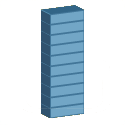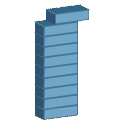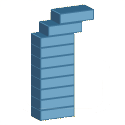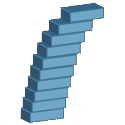



Experiment Category:
Objective:
What You Need:
- 10-15 solid, rectangular blocks all the same size (JENGA Blocks work very well)
- Flat surface
To Do and Observe:
1. Stack the 10 blocks on top of one another. Make sure that they are neat and balanced on the flat surface.
2. Slowly slide the top block over as far as it can go without toppling over.
3. Move the second block and position it to hang over the third block – Be sure to move the top block with it. Now you should have the top and second block hanging as far over the edge without them falling.
4. Continue down the stack, moving each successive block as far over the edge of the block underneath as possible. How many blocks can you balance?
5. While moving the blocks notice how far each block can be moved as compared to the one before it. Try to find a pattern.
What's Going On:
In this activity we have found the balancing point, also knows the center of gravity, of each of the blocks. Every object has a center of gravity. Even you have a center of gravity! The center of gravity is in the very center of the block. That is why the top block could be moved so much, so that the center of it was resting on the block below it. Each time you move a block, you are shifting the center of gravity of the stack resting on it. Try to find the center of gravity of various objects and determine how shape may affect center of gravity.
Parent/Teacher Tips:
Students can use textbooks, or other objects that are rectangular in shape as long as the size stays consistent.
For Younger Students
To do this activity with younger students have them start off with 5 blocks. The blocks or objects should be a little larger in size so that they are easier to manage. Have the students follow the procedure above, observing and comparing the balancing point of each block.
For Older Students
To do this activity with older students have the students follow the procedure above. As they balance each block, have them use a pencil to draw down the edge of the top block on the one below it. After all of the blocks have been balanced, have the students measure the distances and compare them. Is there a mathematical pattern that the structure?
